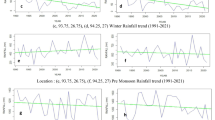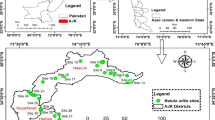Abstract
Studies on spatial distribution of the different forests during 1970 to 1999 using integrated remote sensing and GIS techniques reveals that area under forests in the Kalarani Round, is progressively reducing with the time. In 1970 forest area was found to be 22.75 sq km. in 1989 it was 15.34 sq km and in 1999 it was only 12.93 sq km. Thus. there is considerable loss in the tree cover from 1989 to 1999. Jhanpa and Kalarani R.F. are the example of this. Ground surveys indicate that the majority of the loss is caused by heavy grazing pressure there by decreasing regeneration of vegetation. If suitable measures are not taken. whole area may be converted into wasteland in due course of time. Another reason for the forest loss, could be land encroachments by villagers for their overwhelming needs. Karali R.F. is not much disturbed apart from the plantation raised in the foothills. Outside the reserve forest boundary, the change was observed due to construction of Narmada Sagar canal.
Similar content being viewed by others
References
Anonymous (1976). National Forest Policy. National Commission on Agriculture, Ministry of Agriculture and Cooperation, New Delhi. Anonymous (1980). Gazetteer of India, Vadodara District. A Publication by Government of Gujarat.
Anonymous (1999a). Working Plan for the Forests of Vadodara District (Chhota Udepur Division), Forest Department. Vadodara.
Anonymous (1999b). State of Forest Report. Forest Survey of India, DehraDun.
Das. K. K.. Ravan, S. A., Negi. S. K., Jain. A. and Roy, P. S. (1990). Forest Cover Monitoring using Remote Sensing and GIS — A Case Study in Dhaulkand Range of Rajaji National Park, Uttar Pradesh. J. Indian Soc. Remote Sensing. 20 (1):185–196.
Dhinwa, P. S., Pathan. S. K.. Sastry, S. V., Rao. M.. Majumder, K. L., Chotani. M. L., Singh, J. P. and Sinha, R. L. P. (1992). Land Use Change Analysis of Bharatpur District Using GIS. J. Indian Soc. Remote Sensing, 20(4):237–250.
Forgham, A. (1994). A New Technique for Map Revision and Change Detection Using Merged Landsat TM and SPOT Data Sets in an Urban Environment. Asian-Pacific Remote Sensing Journal, 7(1): 119–128.
Franklin, S. E. and Wilson, B. A. (1991). Vegetation Mapping and Change Detection Using SPOT MLA and Landsat Imagery in Kluane National Park. Can. J. Remote Sensing, 17(1):217–232.
Ghosh, S., Sen, K. K., Rana, U., Rao, K. S. and Saxena, K. G. (1996). Application of GIS for Land-Use/Land-Cover Change Analysis in a Mountainous Terrain. J. Indian Soc. Remote Sensing, 24(3): 194–202.
Igbokwe, J. I. (1999). Geometrical Processing of Multi-Sensor, Multi-Temporal Satellite Images for Change Detection Studies. Int. J. Remote Sensing, 20(6): 1141–1148
Kimothi, M. M. and Juyal, N. (1996). Environmental Impact Assessment of few selected watersheds of the Chamoli District (Central Himalaya) using Remotely Sensed Data. Int. J. Remote Sensing. 17(9):1391–1405.
Kushwaha, S. P. S. (1990). Forest type mapping and change detection from satellite imagery. ISPRS Journal of Photogrammetry and Remote Sensing. 45:175–181.
Lo, C. P. and Shipman, R. L. (1990). A GIS Approach to Land-Use Change Dynamics Detection. Photogrammetric Engineering & Remote Sensing,56(11): 1483–1491.
Macleod, R. D. and Congalton, R. G. (1998). A Quantitative Comparison of Change— Detection Algorithms for Monitoring Eelgrass from Remotely Sensed Data. Photogrammetric Engineering & Remote Sensing, 64(3):207–2I6.
Murthy, K. S. R. and Rao. V. V. (1997). Temporal Studies of Land Use/Land Cover in Varaha River Basin. Andhra Pradesh. India. J. Indian Soc. Remote Sensing, 25(3): 145–154.
Roy, P. S., and Ravan, S. A., (1996). Biomass estimation using satellite remote sensing data An investigation on possible approaches for natural forest. J. Biosci., 21(4):535–561.
Sabins. F. F. (1978). Remote Sensing Principles and Interpretations. W. H. Freeman & Co., San Francisco, USA. pp. 696–697.
Samant, H. P and Subramanyan, V. (1998). Landuse/ Land Cover Changes in Mumbai-Navi Mumbai Cities and Its Effects on the Drainage Basins and Channels— A Study Using GIS. J. Indian Soc. Remote Sensing, 26( 1&2): 1–6
Singh, A., (1989). Digital Change detection technique using remotely sensed data. Int. J. Remote Sensing, 10(6):989–1003.
Wickware, G.M. and Howarth, P.J. (1981). Change Detection in the Peace- Athabasca Delta Using Digital Landsat Data. Remote Sensing Env., 11:9–25.
Author information
Authors and Affiliations
Corresponding author
About this article
Cite this article
Karia, J.P., Porwal, M.C., Roy, P.S. et al. Forest change detection in Kalarani round, Vadodara, Gujarat— a Remote Sensing and GIS approach. J Indian Soc Remote Sens 29, 129–135 (2001). https://doi.org/10.1007/BF02989924
Received:
Revised:
Issue Date:
DOI: https://doi.org/10.1007/BF02989924




